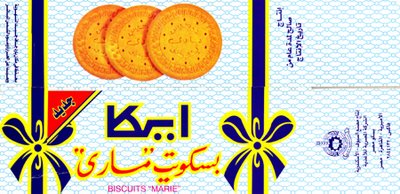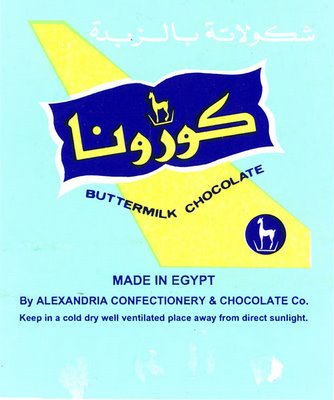 Ramadan is here, with all of its magic and light.
Ramadan is here, with all of its magic and light.Ramadan kareem, everyone. Try not to eat too much kunafa!
Commentary on Egyptian Politics and Culture by an Egyptian Citizen with a Room of Her Own

 Every once in a while, I get a hankering for some of the commodities I grew up with. My memory is crammed with the locally produced goods churned out by our run-down, inefficient state factories of yore, with their no-nonsense packaging and unabashed use of garish primary colours. My retro streak returned recently. For no reason, I recalled Rabso, the all-purpose, can-do detergent in the lemon-yellow box with the flaming red sun surrounded by cheerful soap bubbles.
Every once in a while, I get a hankering for some of the commodities I grew up with. My memory is crammed with the locally produced goods churned out by our run-down, inefficient state factories of yore, with their no-nonsense packaging and unabashed use of garish primary colours. My retro streak returned recently. For no reason, I recalled Rabso, the all-purpose, can-do detergent in the lemon-yellow box with the flaming red sun surrounded by cheerful soap bubbles.  In my biased opinion, Biscuits “Marie” have got to be some of the most delectable cookies ever concocted by man. I grew up on these extremely brittle biscuits with the strong, artificial vanilla flavour and not-quite-crisp texture. Adults of a certain age will remember how the biscuits dissolve immediately the minute they’re dunked in tea. That’s the only way to have them, of course, soaked in black tea, although I recently devoured half a box of dry biscuits on an empty stomach and they were as delightful as ever.
In my biased opinion, Biscuits “Marie” have got to be some of the most delectable cookies ever concocted by man. I grew up on these extremely brittle biscuits with the strong, artificial vanilla flavour and not-quite-crisp texture. Adults of a certain age will remember how the biscuits dissolve immediately the minute they’re dunked in tea. That’s the only way to have them, of course, soaked in black tea, although I recently devoured half a box of dry biscuits on an empty stomach and they were as delightful as ever.
Biscuits “Marie” (no idea why the quote marks) were both a favourite breakfast and a lovely dessert, light and filling at the same time, sublime in their straightforward plainness and absolute spurning of frill, save for the businesslike, faintly Grecian pattern engraved on each biscuit. The only extravagances allowed are the joyful blue-and-yellow ribbons on the package, a bit of whimsy perhaps from the marketing department at Biscomisr?!
Alas, the most excellent Biscuits “Marie” have not escaped the sad fate of Rabso. I’m sad to see them shunted aside on store shelves to make room for the fancy varieties from England, Denmark, and the UAE. In a bid at relevance, Biscomisr has appended an utterly unconvincing “New” to the package. But discerning tasters will know that the cookies have not changed a mote. And thank God for that. In a world of more-is-better and imported-is-best, the Spartan minimalism of my favourite biscuits is a delightful exception. Once upon a time, it was chic to support local industry and buy domestic textiles. Nothing was finer than the threads produced by al-Mahalla al-Kubra’s many public factories. True, their towels and linens come in only limited colours and styles, but so what? I learned to love plain white and stay away from that peachy hue so ubiquitous on sheet sets. And I learned to love the chaotic designs and clashing colours on the Mahalla bath towels: who would have thought that pink and orange are a good combination?!
Once upon a time, it was chic to support local industry and buy domestic textiles. Nothing was finer than the threads produced by al-Mahalla al-Kubra’s many public factories. True, their towels and linens come in only limited colours and styles, but so what? I learned to love plain white and stay away from that peachy hue so ubiquitous on sheet sets. And I learned to love the chaotic designs and clashing colours on the Mahalla bath towels: who would have thought that pink and orange are a good combination?!
This advertisement from the 1970s boasts of the Egypt Textile Company’s productivity, £E34.5 million in exports made possible by 32,000 workers. Now, one by one, Mahalla’s textile companies are being privatised. The workers are laid off or given “early retirement” packages. The designs are spurning beautiful simplicity and embroidery for “modern” prints of large, ungainly flowers, or worse, atrocious “Pharaonic” designs all over the covertas. And for some ridiculous reason, a hideous shade of purple is now ubiquitous on the covertas, which aren’t made of 100% cotton anymore but increasingly incorporate polyester threads. To add insult to injury, there are now fake satin sheet sets that come in the most offensive colours. What is the world coming to?
In a grouchy mood, I went to el-Ghuriyya recently to look for some plain, cotton dinner napkins like the ones I bought years ago but are now too frayed. I didn’t even dare look for linen napkins with beautiful embroidered flowers, I know they’ve been extinct for a long time now. But even decent cotton napkins were nearly impossible to find, and I must have poked my head into every storefront on both sides of el-Ghuriyya and endured the bored stares of the shopkeepers. Finally, a curmudgeonly old vendor reluctantly pulled out a packet from a huge black plastic bag buried in the bottom of a cabinet. He grumbled and complained that the factories are being privatised and don’t sell such things anymore. He made it perfectly clear that I was quite an inconvenience, and yelled at me as if privatisation was my idea. But he did ask me what design I wanted, and let me riffle through them to choose. I picked half a dozen, pearl-white napkins with a subtle white-on-white floral design. They are so pretty I’ve decided not to use them, and keep them clean and folded in the china cabinet drawer. I would now like to confess that I have always loved the stodgy, kitschy Qaha brand, with its cloying jams, syrups, and preserves that come in substandard packaging. I love the brand logo, the rotund orange with the chef’s hat and pea pods for arms. I don’t think I’ve ever seen anything so whimsical. I would buy a Qaha jam any day over any of the concoctions put out by Vitrac, if I can only find them. Metro and other supermarkets have apparently decided that selling Qaha is not chic, as a manager there told me in so many words. They prefer to stock their shelves with the American Smucker’s and various products from Central Europe, since of course anything imported is automatically….more chic.
I would now like to confess that I have always loved the stodgy, kitschy Qaha brand, with its cloying jams, syrups, and preserves that come in substandard packaging. I love the brand logo, the rotund orange with the chef’s hat and pea pods for arms. I don’t think I’ve ever seen anything so whimsical. I would buy a Qaha jam any day over any of the concoctions put out by Vitrac, if I can only find them. Metro and other supermarkets have apparently decided that selling Qaha is not chic, as a manager there told me in so many words. They prefer to stock their shelves with the American Smucker’s and various products from Central Europe, since of course anything imported is automatically….more chic.
This ad from the 1970s was Qaha’s attempt to remain relevant when faced with the influx of Infitah-era foreign competitors. Overnight, Qaha company became “the symbol of progress,” boasting boxed juices, frozen vegetables (packaged in polyethylene bags!), and pure honey. I suppose the blond children in the ad were an assurance of just how progressive Qaha is. Still, and despite the desperate advertising, I love Qaha, especially its apricot jam and juice. I’d like to pay tribute to it now, before it disappears for good, if it hasn’t already. Like Safinaz Kazem, I don’t much appreciate nostalgia, but there are always exceptions. If Korona were to ever compete with other chocolates, there’s no doubt in my mind that it would barely make the bottom of the list. It’s too sweet, the chocolate used is obviously mediocre, and it’s always too soft no matter what the temperature is. It doesn’t melt in your mouth so much as stick there in a heavy lump (am I right?) But to my seven-year-old palate, Korona is the best chocolate in the world. It’s the most exciting treat in the world. Korona reminds me of the excitement and perpetual sense of wonder of my childhood. It reminds me of going to Um Sana’ all by myself and buying it along with bim bim (coca-cola flavour, please). Every time I walk into a baqqal now, my eye zooms in on the neat teal square lying forlornly in the fridge, overtaken by Toblerone and Twix. The grocer devastates me with his offhand remark, “children don’t prefer it now.” Maalesh, maybe one day they’ll rediscover its ordinary charm.
If Korona were to ever compete with other chocolates, there’s no doubt in my mind that it would barely make the bottom of the list. It’s too sweet, the chocolate used is obviously mediocre, and it’s always too soft no matter what the temperature is. It doesn’t melt in your mouth so much as stick there in a heavy lump (am I right?) But to my seven-year-old palate, Korona is the best chocolate in the world. It’s the most exciting treat in the world. Korona reminds me of the excitement and perpetual sense of wonder of my childhood. It reminds me of going to Um Sana’ all by myself and buying it along with bim bim (coca-cola flavour, please). Every time I walk into a baqqal now, my eye zooms in on the neat teal square lying forlornly in the fridge, overtaken by Toblerone and Twix. The grocer devastates me with his offhand remark, “children don’t prefer it now.” Maalesh, maybe one day they’ll rediscover its ordinary charm.